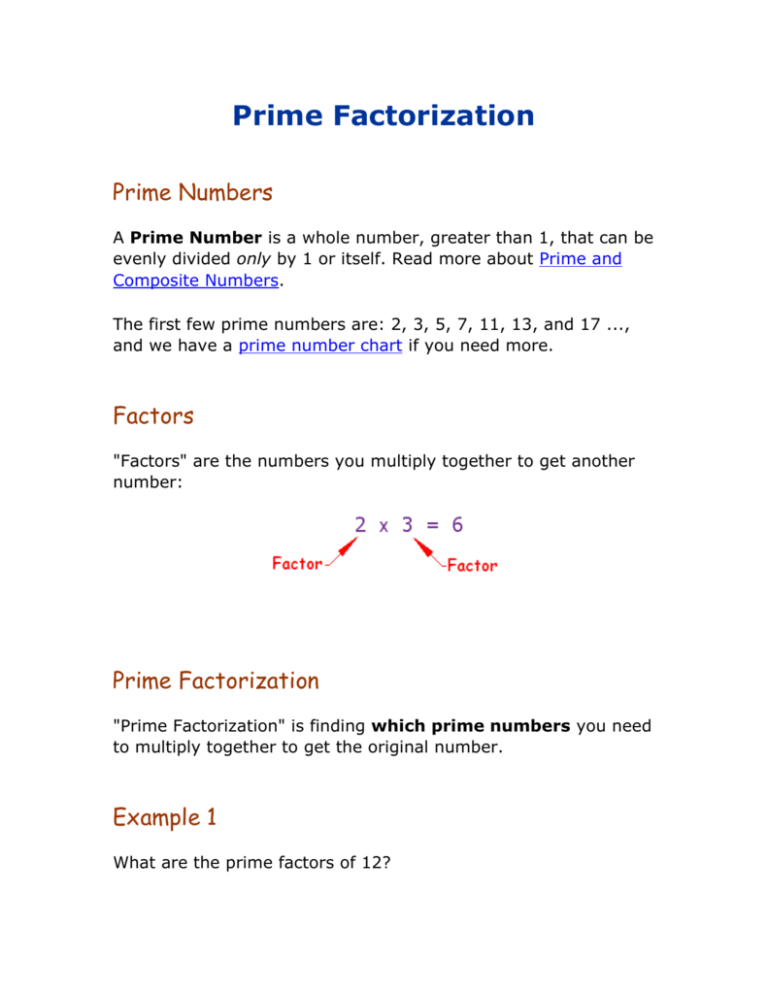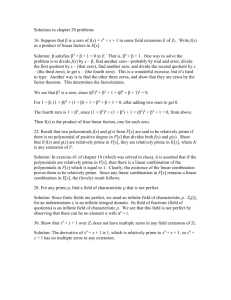Prime Factorization Guide
advertisement

Prime Factorization Prime Numbers A Prime Number is a whole number, greater than 1, that can be evenly divided only by 1 or itself. Read more about Prime and Composite Numbers. The first few prime numbers are: 2, 3, 5, 7, 11, 13, and 17 ..., and we have a prime number chart if you need more. Factors "Factors" are the numbers you multiply together to get another number: Prime Factorization "Prime Factorization" is finding which prime numbers you need to multiply together to get the original number. Example 1 What are the prime factors of 12? It is best to start working from the smallest prime number, which is 2, so let's check: 12 ÷ 2 = 6 But 6 is not a prime number, so we need to factor it further: 6÷2=3 And 3 is a prime number, so: 12 = 2 × 2 × 3 As you can see, every factor is a prime number, so the answer must be right - the prime factorisation of 12 is 2 × 2 × 3, which can also be written as 22 × 3 Example 2 What is the prime factorization of 147? Can we divide 147 evenly by 2? No, so we should try the next prime number, 3: 147 ÷ 3 = 49 Then we try factoring 49, and find that 7 is the smallest prime number that works: 49 ÷ 7 = 7 And that is as far as we need to go, because all the factors are prime numbers. 147 = 3 × 7 × 7 = 3 × 72 Why? A prime number can only be divided by 1 or itself, so it cannot be factored any further! Every other number can be broken down into prime number factors. So, in a way, the prime numbers are the building blocks of all other numbers. And there is only one (unique!) set of prime factors for any number. Example The prime factors of 330 are 2, 3, 5 and 11. There is no other possible set of prime numbers that can be multiplied to make 330. In fact this idea is so important it is called the Unique Factorization Theorem, and also the Fundamental Theorem of Arithmetic. Wow! Cryptography In fact Prime Factorization is very important to people who try to make (or break) secret codes based on numbers. If you want to know more, the subject is "encryption" or "cryptography". Another Method We showed you how to do the factorization by starting at the smallest prime and working upwards, but sometimes it is easier to break a number down into any factors you can, then work those factor down to primes. Example: What are the prime factors of 90? Break 90 into 9 × 10 The prime factors of 9 are 3 and 3 The prime factors of 10 are 2 and 5 So the prime factors of 90 are 3,3, 2 and 5 Prime Factorization Tool OK, we have one more method ... use our Prime Factorization Tool that can work out the prime factors for numbers up to 2,147,483,647.








